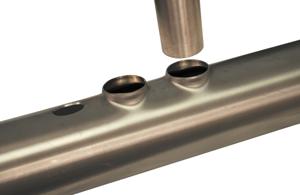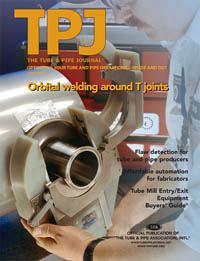- FMA
- The Fabricator
- FABTECH
- Canadian Metalworking
Categories
- Additive Manufacturing
- Aluminum Welding
- Arc Welding
- Assembly and Joining
- Automation and Robotics
- Bending and Forming
- Consumables
- Cutting and Weld Prep
- Electric Vehicles
- En Español
- Finishing
- Hydroforming
- Laser Cutting
- Laser Welding
- Machining
- Manufacturing Software
- Materials Handling
- Metals/Materials
- Oxyfuel Cutting
- Plasma Cutting
- Power Tools
- Punching and Other Holemaking
- Roll Forming
- Safety
- Sawing
- Shearing
- Shop Management
- Testing and Measuring
- Tube and Pipe Fabrication
- Tube and Pipe Production
- Waterjet Cutting
Industry Directory
Webcasts
Podcasts
FAB 40
Advertise
Subscribe
Account Login
Search
Teeing up orbital welding
Forming, welding processes make a hole-in-one
- By John Hodges
- June 3, 2009
- Article
- Tube and Pipe Fabrication
Two innovative techniques have come together to improve the quality and decrease the cost of fabricating high-purity systems, such as those used in
the food and beverage, dairy, pharmaceutical, and semiconductor industries. These two techniques are mechanically formed T connections and orbital welding.Two common requirements in these industries concern distribution systems and the materials used to make them. They use manifold distribution systems for clean-in-place subsystems, gas and process fluid distribution, as well as filter and heat exchanger subsystems. These systems must be fabricated from polished austenitic stainless steel tube typically joined by an autogenous, or fusion, butt weld. When done correctly, this type of weld results in a joint that is strong with no crevices or porosity to trap process material that might later contaminate the product.
One method for producing these manifolds is to form the branch connections mechanically out of the run tube (see Figure 1). This minimizes the welding required, which minimizes leak paths and areas that could trap contamination. It also reduces the tube polishing required at the weld points.
Orbital welding has gained widespread acceptance, and it is becoming a requirement for various applications in many industries. The process is fast and provides consistent, quality welds, and thereby helps to control fabrication costs. Furthermore, the issuance of ASME Bioprocessing Equipment 2007 (BPE-2007) as the standard for high-purity systems has increased the use of orbital welding equipment in the biopharmaceutical industry.
Because mechanical forming and orbital welding offer advantages for high-purity applications, one frequently asked question is, Can orbital welding be used on mechanically formed T connections? It can, but these two processes have characteristics and limitations that must be evaluated carefully.
Application Evaluation
Four considerations are material compatibility, collar height, collar ovality, and collar wall thickness.
Material Compatibility. The materials used most often in these systems are specified in ASTM A269, Standard Specification for Seamless and Welded Austenitic Stainless Steel Tubing for General Service, and ASTM A270, Standard Specification for Seamless and Welded Austenitic Stainless Steel Sanitary Tubing: 304, 304L, 316, and 316L. These materials possess excellent cold-forming characteristics. While all four are suitable for mechanically forming T connections and for orbital welding, additional chemical requirements improve the welds. For example, the sulfur content of the two mating pieces must be as equal as possible. Keeping the sulfur content of the two pieces at the same end of the allowable range is usually sufficient.
Collar Height. Collar heights for mechanically formed branch connections typically are from 0.100 inch to 0.250 in. in these materials. The maximum collar height possible is most influenced by the type of material and its ductility. In some cases, it can be as high as 0.375 in.
The branch connection's collar height is proportionate to the collar diameter; as the diameter grows, so does the collar height.
Collar Ovality. All mechanically formed outlets are oval due to the inherent distribution of stresses in the tube or pipe. The ovality of the outlet falls within the allowed ovality tolerance for tube or pipe. This means that the welder determines which orientation and fit-up are the best.
This is not unique to welding collars; the welder does this also when using orbital welding to join two lengths of straight pipe. As any pipe welder can tell you, straight tube is never straight and the hole is never in the middle. In fact, welding collars might be easier because, unlike random lengths of straight tube, the ovality for a mechanically formed T connection is consistent and predictable.
Collar Wall Thinning. All mechanically formed T connections have some degree of wall thinning. The amount and distribution depend on the T ratio and the correct dimensioning of the pilot hole. The T ratio is simply the ratio of the diameter of the branch to the diameter of the run tube. Wall thinning increases as the T ratio approaches 1.
Equipment for Welding T's
The mechanical aspects—wall thinning, ovality, and collar height—are three chief concerns in these applications. Using power supplies and accessories specifically designed for T's is the key to good welding results.
Power Supplies. Modern orbital welding power supplies can be programmed to accommodate variations in material and wall thickness, as long as the locations and amounts of thinning are known. Some automatically vary the amperage in response to feedback during the welding process, adjusting themselves for variations in wall thickness. This degree of sophistication is helpful, but in general it is not necessary for making a good weld.
Accessories. Although ovality and wall thinning do not materially affect the welding process, the collar height is critical. Standard orbital weld heads require a minimum amount of clamping surface on the tube to align the tube, position the electrode, and establish a gas shielding area. It is common that a mechanically formed T does not have enough collar height or material to allow a standard orbital weld head to clamp to it.
One way to deal with this situation is to use an adapter kit (see Figure 2). This consists of an offset electrode and a plastic or fiberglass gas shield that fits the run tube diameter. The welder first orients and tack-welds the mating tube to the run tube. Then he attaches the equipment (weld head and gas shield) and completes the weld.
Another solution is a modified clamp and shield system (see Figure 3). This eliminates the tack weld step. It may require an adjustable-position or offset electrode.
Both these solutions solve the alignment, clamping, and gas shielding issues. In other words, they change the parameters. The minimum required collar height is not determined by the ability to align and clamp, but instead by the minimum amount of material required to make a good weld. In general, this is 11/2 times the branch tube wall thickness.
Using these technologies in combination is suitable for applications other than sanitary tubing. They can be used together, and offer similar advantages, for stainless steel piping applications in general.
About the Author
About the Publication
Related Companies
subscribe now

The Tube and Pipe Journal became the first magazine dedicated to serving the metal tube and pipe industry in 1990. Today, it remains the only North American publication devoted to this industry, and it has become the most trusted source of information for tube and pipe professionals.
start your free subscription- Stay connected from anywhere

Easily access valuable industry resources now with full access to the digital edition of The Fabricator.

Easily access valuable industry resources now with full access to the digital edition of The Welder.

Easily access valuable industry resources now with full access to the digital edition of The Tube and Pipe Journal.
- Podcasting
- Podcast:
- The Fabricator Podcast
- Published:
- 04/16/2024
- Running Time:
- 63:29
In this episode of The Fabricator Podcast, Caleb Chamberlain, co-founder and CEO of OSH Cut, discusses his company’s...
- Trending Articles
Fabricator achieves extraordinary with simple approach

Team Industries names director of advanced technology and manufacturing

New trails, old-school values for Precision Tube Laser

Orbital tube welding webinar to be held April 23

Blades designed for cutting medium metals

- Industry Events
16th Annual Safety Conference
- April 30 - May 1, 2024
- Elgin,
Pipe and Tube Conference
- May 21 - 22, 2024
- Omaha, NE
World-Class Roll Forming Workshop
- June 5 - 6, 2024
- Louisville, KY
Advanced Laser Application Workshop
- June 25 - 27, 2024
- Novi, MI



























